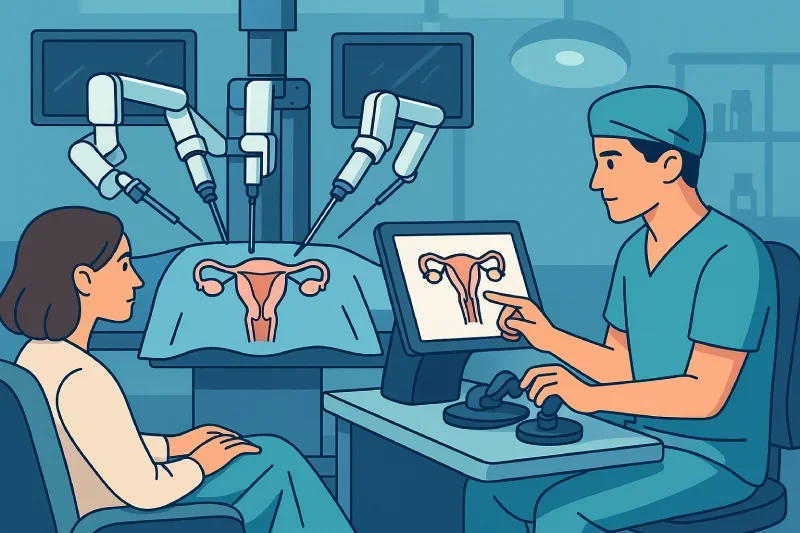Who Is Not a Candidate for Robotic Surgery in Burleson, TX?
Categories:
By: Ethan Cole
Robotic technology has changed the face of modern medicine, but even the most advanced surgical systems—whether a da Vinci® surgical system in urology or a robotic-arm assisted technology platform in orthopedics—have limitations. Understanding those limits helps you and your surgeon decide if a minimally invasive approach is truly safer than traditional open surgery.
Below, we outline the patient profiles that often disqualify candidates, compare surgical options, and explain how a specialist in Burleson or nearby Fort Worth, TX, makes the final call.
Key Takeaways
Robotic surgery offers smaller incisions, reduced blood loss, and faster recovery times, but serious heart or lung disease, uncontrolled bleeding disorders, or extreme obesity can outweigh the benefits of robotic assistance.
Skeletal immaturity, compromised bone stock, active infection, and cirrhosis frequently steer surgeons toward conventional open surgery or laparoscopy.
Each case is unique; a thorough surgery consultation in Fort Worth or Burleson, TX, includes imaging, labs, and cardiopulmonary testing to verify candidacy.
Non-surgical and surgical options—such as physical therapy, medication, or standard joint replacement surgery—remain highly effective when robotics are unsafe.
Potential Exclusion Factors for Robotic Surgery
BMI > 40 (sometimes > 35 for joint procedures)
Advanced COPD or severe cardiac disease
Active systemic or joint infection
Cirrhosis or coagulation disorders
Skeletal immaturity or poor bone quality
Bowel obstruction or dense adhesions
Neuromuscular conditions affecting stability
Robotic Surgery in TX: When the Benefits of Robotic Do Not Outweigh the Risks
The benefits of robotic procedures—high-definition, magnified view of the surgical area, wrist-like instrument articulation, and an overall reduced risk of infection—are well-documented. Yet in certain patients these advantages are negated by physiologic stress, limited working space, or a heightened risk of complications. That’s why even the 1 provider of robotic surgery in North Texas will insist on a detailed evaluation before booking the operating room.
Severe Cardiopulmonary Disease
Robotic-assisted surgery, whether laparoscopic surgery and robotic-assisted surgery combined or pure robotic, requires general anesthesia and, in abdominal cases, carbon-dioxide insufflation. Both increase intrathoracic pressure, which can strain a weak heart or lungs. A patient with unstable angina, an ejection fraction below 30 percent, or advanced COPD may be safer with an open surgery or a minimally invasive laparoscopic procedure that avoids high insufflation pressures.
Extreme Obesity (BMI > 40)
A high BMI narrows the operative field and lengthens recovery time. Instruments on a robotic arm have finite reach; too much adipose tissue forces the surgeon to convert to other surgical techniques mid-procedure, erasing any potential advantage. Most Burleson and Fort Worth specialists cap robotic knee replacement and minimally invasive kidney surgery at a BMI of 40—and some set the bar at 35.
Bleeding & Clotting Disorders
Robotic surgery usually means reduced blood loss, but only when the patient’s coagulation status is stable. Hemophilia, von Willebrand disease, and anticoagulation that cannot be paused raise the risk of uncontrolled hemorrhage around trocar and robotic arm entries. When reversal agents or factor infusions fail to normalize labs, traditional open surgery requires fewer ports and allows direct control of bleeding vessels.
Active Infection
Whether you’re considering partial knee replacement, total knee replacement, or minimally invasive surgery for kidney tumors, an untreated infection can seed the surgical area. Surgeons to perform complex procedures such as joint replacement surgery will postpone until cultures clear, then reassess whether surgery with da Vinci technology is appropriate.
Minimally Invasive Kidney Surgery, Knee Replacement, and Other Advanced Surgical Procedures—Who May Be a Candidate?
Recent advances allow da Vinci-guided nephrectomy and robotic-arm assisted total knee replacement through incisions barely two inches long. These advanced surgical procedures provide faster recovery periods and earlier return to normal activities, but only for patients who can maintain stable anatomy and hemodynamics during the operation.
Kidney patients undergo a kidney surgery consultation in Forth (Fort) Worth at the Texas Center for Urology. The center for urology provides da Vinci minimally invasive surgery but screens out severe cirrhotics and those with uncorrected coagulopathy.
Orthopedic patients see Lone Star Orthopaedic and Spine Specialists for hip replacement or total knee replacement. Star Orthopaedic and Spine Specialists use a Mako robotic system, yet exclude those with poor bone stock or neuromuscular instability.
Robotic-Arm Assisted Technology for Knee Replacement and Joint Replacement Surgery: Contraindications
Robotic-arm assisted technology relies on CT-based mapping. Osteoporosis, mal-unions, or prior hardware can distort landmarks, making robotic alignment less reliable than custom jig or navigation systems. Likewise, skeletal immaturity means bones still grow, shifting implant position over time. Your orthopaedic surgeon weighs the long-term range of motion and implant survival before committing to robotic assistance.
From Kidney Surgery Consultation in Fort Worth to Surgery Consultation in Fort Worth—How a Specialist Decides
During your surgery consultation in Fort Worth, the specialist compares traditional open surgery, basic laparoscopic surgery, and robotic-assisted surgery. The doctor can determine whether surgery with da Vinci provides a measurable advantage. If not, they may recommend:
Standard laparoscopy—fewer ports, no balloon abdomen, shorter anesthesia time.
Open approach—especially if extensive adhesions predict difficult visualization.
Hybrid plan—start robotic, convert to open if exposure or bleeding becomes unsafe.
Recovery Period Following Robotic Surgery vs. Traditional Open Surgery
When successful, the robotic approach decreases trauma to the patient, shortens the recovery period, and lowers the risk of complications:
Smaller incisions mean less postoperative pain and discomfort.
High-definition 3D optics allow precise cuts, preserving healthy tissue.
Reduced blood loss limits need for transfusion.
Most patients walk on the same day and resume light work within two weeks, compared with six weeks for open procedures.
Still, if you are not a candidate, rest assured that open techniques have decades of proven safety and effectiveness. Surgeons continually refine these methods, and outcomes of robotic and non-robotic surgery often converge once rehabilitation is complete.
Safety and Effectiveness: The Bottom Line
You may be a candidate for robotic-assisted surgery if you have:
Stable cardiopulmonary function
Controlled body weight (BMI < 40)
No active infection or coagulopathy
Sufficient bone quality (for orthopedics)
Realistic expectations and commitment to rehab
If any of these conditions are unmet, your surgeon will explain why a different surgical procedure—or sometimes a non-surgical plan—is the wiser choice. Conversion to other surgical techniques is never a failure; it is a safety net built into responsible surgical planning.
Conclusion
Robotic surgery, whether powered by the da Vinci system for urology or a precision robotic arm for knee replacement, represents a leap in advanced surgical techniques. Yet heart disease, severe obesity, bleeding disorders, cirrhosis, skeletal immaturity, and ongoing infection can eliminate its advantages.
A qualified surgeon in Burleson or Fort Worth, TX, will balance every factor, from recovery time to the potential impact of robotic instrumentation, before recommending the best path. Schedule your personalized evaluation today to learn which surgical options align with your health goals and lifestyle.
Find out if robotic surgery is right for you.
Call (817) 568-8731Categories:
Frequently Asked Questions
-
Robotic systems translate the surgeon’s hand movements into micro-motions, offering a tremor-free, magnified view. While both techniques are minimally invasive, robotic platforms like the da Vinci® surgical system provide greater articulation and precision, which can reduce blood loss and shorten recovery time compared with conventional laparoscopy.
-
Yes. Safety dictates that surgeons always prepare to convert to other surgical techniques if bleeding, poor visualization, or equipment malfunction occurs. This flexibility ensures patient safety remains the top priority, even in the most advanced surgical environments.
-
No. Robotic-arm assisted technology now supports both partial and total knee replacement. Your orthopedic specialist will decide which option suits your joint damage, alignment, and overall health profile, as well as whether the robotic approach will improve implant accuracy.
-
Most patients experience a shorter recovery period—often returning to normal activities in two to three weeks compared with four to six weeks after traditional open surgery. However, exact timelines depend on the procedure type, age, and overall health.
-
While the da Vinci system offers high-definition, 3D visualization and wrist-like instrument movement, outcomes still depend on the surgeon’s skill, case complexity, and patient health. A doctor can determine whether surgery with da Vinci will genuinely improve your specific results.
-
A BMI over 40 can limit instrument reach and increase complication risk. Many centers, including those offering surgery in Fort Worth, set BMI limits to ensure optimal visibility, lower infection risk, and faster recovery times.
-
Absolutely. Physical therapy, weight management, injections, or medication adjustments often relieve symptoms. When surgery is necessary, traditional open surgery or standard laparoscopy can still provide safe, effective treatment with excellent long-term outcomes.
-
Studies show a reduced risk of infection, less blood loss, and fewer readmissions with robotic assistance when patients are properly selected. However, inappropriate candidacy can negate these benefits, making patient selection critical.
-
Texas Center for Urology provides da Vinci minimally invasive surgery, and several Fort Worth hospitals partner with specialists credentialed on the da Vinci system. A kidney surgery consultation in Fort Worth will confirm whether you qualify.
-
Contact a board-certified surgeon’s office—such as Lone Star Orthopedic and Spine or Texas Center for Urology—for an initial evaluation. Bring prior imaging and medical records so the provider of robotic surgery procedures can quickly determine whether robotic, laparoscopic, or open surgery is appropriate for you.












